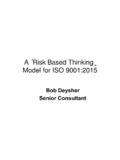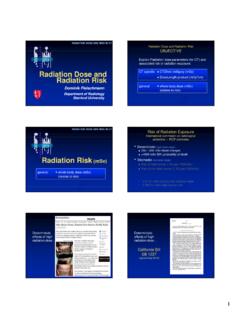Transcription of DEPARTMENT OF HEALTH & HUMAN SERVICES Washington, …
1 1 DEPARTMENT OF HEALTH & HUMAN SERVICES Centers for Medicare & Medicaid SERVICES Center for Consumer Information and Insurance Oversight 200 Independence Avenue SW Washington, DC 20201 Date: July 19, 2021 Subject: Updated 2022 Benefit Year Final HHS Risk Adjustment Model Coefficients In part 2 of the HHS Notice of Benefit and Payment parameters for 2022 final rule (2022 Payment Notice), we finalized the risk adjustment models for the 2022 benefit year, including the associated risk adjustment model The 2022 benefit year coefficients included in this final rule contained a few errors that impacted certain factors for the adult models.
2 Consistent with 45 (b)(1)(i), this document announces some minor revisions to the 2022 benefit year final risk adjustment adult model coefficients. The reason for these revisions is to apply a constraint to the enrollment duration factors (EDFs) that was missing in the 2022 Payment Notice s risk adjustment model coefficients. During all risk adjustment model recalibrations, we impose constraints on certain coefficients for a variety of reasons, such as small sample size or to maintain hierarchical condition category (HCC) Since the EDFs were added to the adult models,3 we have imposed a constraint to ensure that the EDFs coefficients decrease monotonically as the number of months increases.
3 That is, the 1-month EDFs are always equal to or larger than the 2-month EDFs, the 2-month EDFs are equal to or larger than the 3-month EDFs, and so on. During the 2022 benefit year model recalibration between the publication of the proposed coefficients (which reflected the proposed changes to the EDFs4) and the publication of the final coefficients in the 2022 Payment Notice (which did not include the proposed EDF changes), we did not apply the EDF constraint. This resulted in the 3-month EDFs having larger values than the 2-month EDFs in the 2022 risk adjustment models that were finalized in the 2022 Payment Notice.
4 CMS identified and recalibrated the impacted coefficients to incorporate the EDF constraint and is releasing updated final adult model coefficients for the 2022 benefit year accordingly. The 1 Patient Protection and Affordable Care Act; HHS Notice of Benefit and Payment parameters for 2022 and Pharmacy Benefit Manager Standards; Final Rule, 86 FR 24140 (May 5, 2021), available at: 2 See, , Potential Updates to HHS-HCCs for the HHS-operated Risk Adjustment Program, June 17, 2019 and (Available at: ) and HHS-Operated Risk Adjustment Methodology Meeting, Discussion Paper, March 24, 2016 (Available at: ).
5 3 Patient Protection and Affordable Care Act; HHS Notice of Benefit and Payment parameters for 2018; Amendments to Special Enrollment Periods and the Consumer Operated and Oriented Plan Program; Final Rule, 81 FR 94058 (December 22, 2016). 4 Patient Protection and Affordable Care Act; HHS Notice of Benefit and Payment parameters for 2022 and Pharmacy Benefit Manager Standards; Updates to State Innovation Waiver (Section 1332 Waiver) Implementing Regulations; Proposed Rule, 85 FR 78572 at 78583 78586 (December 4, 2020).
6 2 correction involved the 1-month, 2-month, and 3-month EDFs, and the overall impact of this update is ,6 For convenience, we also include the final 2022 benefit year coefficients for the child and infant models in this document so that issuers will have the complete final set of coefficients in one document for reference, even though no changes were made to those coefficients. We highlighted the impacted adult model coefficients in Table 1 for ease of reference. These coefficients will replace the coefficients finalized in the 2022 Payment Notice and will apply to the 2022 benefit year risk adjustment program.
7 The tables below show the updated final coefficients for the 2022 benefit year for the adult risk adjustment models (Table 1), as well as the final coefficients for the 2022 benefit year child risk adjustment models (Table 2) and infant risk adjustment models (Table 3). All other tables that were published in the 2022 Payment Notice final rule are still applicable. 5 For example, the previously finalized silver model 2- and 3-month EDFs are and , respectively.
8 The updated coefficients published in this document fall between these values, so the difference between the current and updated coefficients is less than 6 The coefficients impacted include the 1-month, 2-month and 3-month EDFs in the adult models for all metal levels as well as HCC057 and RXC09 x HCC057 in the adult models for the silver and bronze metal levels. The small changes to HCC057 and RXC09 x HCC 057 (.001 each) are likely due to RXC09-related factors being blended from 2016 & 2017 only, and not using the (unchanged) 2018 coefficient estimates.
9 See 86 FR at 24180. Additionally, constraining any coefficient in a multiple regression can slightly affect all other coefficients in the regression. The magnitude of the effect is dependent upon how closely related the variables are to the variable being constrained. 3 TABLE 1: Final Adult Risk Adjustment Model Factors for 2022 Benefit Year HCC or RXC No. Factor Platinum Gold Silver Bronze Catastrophic Demographic Factors Age 21-24, Male Age 25-29, Male Age 30-34, Male Age 35-39, Male Age 40-44, Male Age 45-49, Male Age 50-54, Male Age 55-59, Male Age 60-64, Male Age 21-24, Female Age 25-29, Female Age 30-34, Female Age 35-39, Female Age 40-44, Female Age 45-49, Female Age 50-54.
10 Female Age 55-59, Female Age 60-64, Female Diagnosis Factors HCC001 HIV/AIDS HCC002 Septicemia, Sepsis, Systemic Inflammatory Response Syndrome/Shock HCC003 Central Nervous System Infections, Except Viral Meningitis HCC004 Viral or Unspecified Meningitis HCC006 Opportunistic Infections HCC008 Metastatic Cancer HCC009 Lung, Brain, and Other Severe Cancers, Including Pediatric Acute Lymphoid Leukemia HCC010 Non-Hodgkin Lymphomas and Other Cancers and Tumors HCC011 Colorectal, Breast (Age < 50), Kidney, and Other Cancers HCC012 Breast (Age 50+) and Prostate Cancer, Benign/Uncertain Brain Tumors, and Other Cancers and Tumors 4 HCC or RXC No.

















